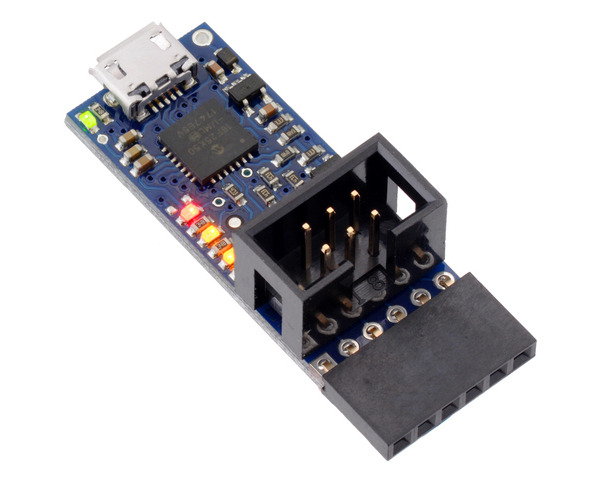

This is a merged information page for Item #3172.
View normal product page.
Pololu item #:
3172
Brand:
Pololu
Status:
Active and Preferred

This in-system programmer can be used to program AVR microcontrollers and AVR-based controller boards, such as our A-Star 328PB Micro, Orangutan robot controllers, and the 3pi robot. The programmer emulates an STK500 on a virtual serial port, making it compatible with standard AVR programming software, and it supports devices running at either 3.3 V or 5 V. The programmer also features a TTL-level serial port, enabling general-purpose serial communication for debugging or programming microcontrollers with a serial bootloader. An ISP cable and a 1×6 double-sided male header are included with this fully-assembled programmer.
 Compare all products in Computer Interface.
Compare all products in Computer Interface.
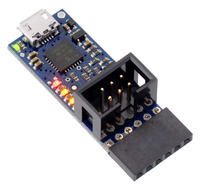 |
Pololu USB AVR Programmer v2.1. |
|---|
 |
Pololu USB AVR Programmer v2 or v2.1 with included hardware. |
|---|
 |
Pololu USB AVR Programmer v2.1, bottom view with dimensions. |
|---|
 |
Pololu USB AVR Programmer v2.1, bottom view. |
|---|
 |
Pololu USB AVR Programmer v2.1, top view. |
|---|
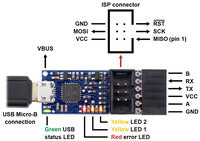 |
Pololu USB AVR Programmer v2.1, labeled top view. |
|---|
 |
Pololu USB AVR Programmer v2.1, connected to a USB cable (not included). |
|---|
 |
The Pololu USB AVR Programmer v2 (bottom) connected to an A-Star 32U4 Prime SV for programming. |
|---|
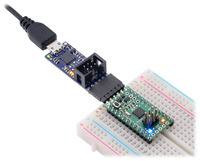 |
A-Star 328PB Micro connected to the serial pins of a Pololu USB AVR Programmer v2.1. |
|---|
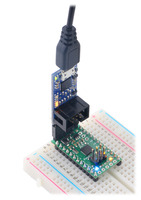 |
A-Star 328PB Micro connected to the serial pins of a Pololu USB AVR Programmer v2.1. |
|---|
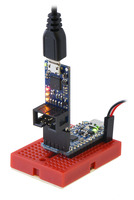 |
The Pololu USB AVR Programmer v2 (top) connected to an Adafruit Pro Trinket for programming. |
|---|
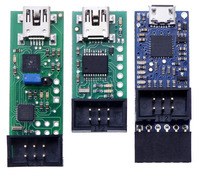 |
From left to right: the original Orangutan USB Programmer, the Pololu USB AVR Programmer, and the Pololu USB AVR Programmer v2 (which looks almost the same as v2.1). |
|---|
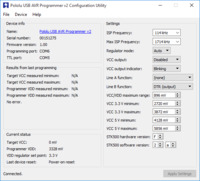 |
The Pololu USB AVR Programmer v2 Configuration Utility in Windows 10. |
|---|
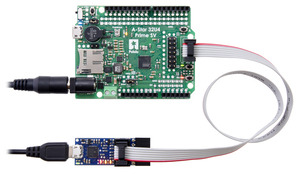 |
The Pololu USB AVR Programmer v2 (bottom) connected to an A-Star 32U4 Prime SV for programming. |
|---|
The Pololu USB AVR Programmer v2.1 is a compact, low-cost in-system programmer (ISP) for AVR microcontrollers from Atmel (now a part of Microchip). The programmer provides an interface for transferring a compiled AVR program from your computer to the target AVR’s non-volatile memory, allowing it to run the program. It is a good solution for programming AVR-based controllers like our A-Star 328PB Micro and Orangutan robot controllers. It can also be used to update, replace, or remove the bootloader on some Arduino boards including the Uno, Leonardo, and Mega, and also on our Arduino-compatible A-Star controllers. This programmer is designed to work well with both 3.3 V and 5 V devices, and it can even be configured to provide power to the target device in low-power systems.
The programmer connects to your computer’s USB port via a standard USB A to Micro-B cable (not included) and communicates with your programming software, such as Microchip Studio, AVRDUDE, or the Arduino IDE, through a virtual COM port using the STK500 protocol. The programmer connects to your target device via an included 6-pin ISP programming cable (the older, 10-pin ISP connections are not directly supported, but it’s easy to create or purchase a 6-pin-to-10-pin ISP adapter). The programmer also acts as a USB-to-TTL serial adapter, providing a TTL-level serial port that can be used to communicate with other serial devices from your computer. It ships fully assembled with connectors soldered in as shown.
The Pololu USB AVR Programmer v2.1 is a drop-in replacement for the older Pololu USB AVR Programmer v2 with several hardware improvements that are described in the “Comparison to previous AVR programmers” section below.
This product requires a USB A to Micro-B cable to connect to a computer.
 |
 |
The programmer should work with all AVRs that can be programmed with the AVR ISP (in-system programming) interface, which is also known as in-circuit serial programming (ICSP), serial programming, or serial downloading, but it has not been tested with all devices. We expect it to work with most AVRs in the megaAVR (ATmega) family, and it works with some members of the tinyAVR (ATtiny) family, but it does not support the Tiny Programming Interface (TPI), and it does not work with the XMEGA family or with 32-bit AVRs. The programmer features upgradable firmware, allowing updates for future devices.
The programmer is designed for use with AVR microcontrollers running at either 3.3 V or 5 V. By default, the programmer expects the target to be self-powered, but it can be configured to deliver power to the target device in low-power systems.
We support using the Pololu USB AVR Programmer v2.1 and its configuration software on desktop versions of Windows (7, 8, 10, and 11), Linux, and macOS 10.11 or later. Older versions of Windows are not supported.
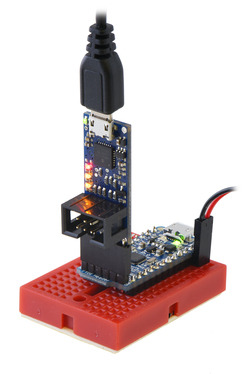 |
The Pololu USB AVR Programmer v2 (top) connected to an Adafruit Pro Trinket for programming. |
|---|
This programmer doubles as a USB-to-serial adapter. The programmer installs as two virtual COM ports: one for communicating with programming software and one for general-purpose serial communications. This means that you can seamlessly switch between programming an AVR and debugging it through the TTL serial port without having to open and close your terminal program. In addition to the serial transmit (TX) and receive (RX) lines, the programmer lets you use A and B as serial handshaking lines that can be configured using our software.
The six pins on the serial header (GND, A, VCC, TX, RX, and B) are arranged to be similar to the pinout of commonly-available FTDI USB-to-serial cables and breakout boards. In the default configuration, pin B is used as the DTR output (and pin A is an unused input), which allows you to plug the programmer directly into a variety of Arduino-compatible boards (including our A-Star 328PB Micro) and use it to upload programs to the board via a serial bootloader.
The Pololu USB AVR Programmer v2.1 ships fully assembled with ISP and serial connectors soldered in, and it includes the accessories shown in the picture below. The 6-pin ISP cable can be used to program AVRs. The 1×6 double-sided male header can be plugged into the serial header to effectively reverse its gender (making it possible to connect that header to a breadboard or female jumper wires).
 |
Pololu USB AVR Programmer v2 or v2.1 with included hardware. |
|---|
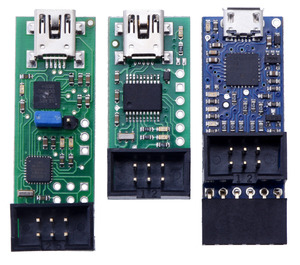 |
From left to right: the original Orangutan USB Programmer, the Pololu USB AVR Programmer, and the Pololu USB AVR Programmer v2 (which looks almost the same as v2.1). |
|---|
The Pololu USB AVR Programmer v2.1 (product #1372) is a drop-in replacement for our older Pololu USB AVR Programmer v2 (product #3170) with three hardware improvements:
Compared to the original Pololu USB AVR Programmer (product #1300), the Pololu USB AVR Programmer v2.1 features a number of improvements:
This v2.1 programmer does not include a USB cable, and it does not have the SLO-scope bonus feature. In addition to these changes, many other details are different between the v2.1 programmer and the original; please be sure to refer to the user’s guide for the v2.x programmers to familiarize yourself with this programmer.
| PCB dev codes: | pgm04b |
|---|---|
| Other PCB markings: | 0J11125 |
User’s manual for the Pololu USB AVR Programmer v2.
This guide explains how to get started programming your Orangutan or 3pi Robot in Windows, Linux or Mac OS X. It covers setting up an AVR development environment (Atmel Studio for Windows users), installing the Pololu AVR C/C++ Library, and setting up the Pololu USB AVR Programmer.
This installer contains the drivers and software for the Pololu USB AVR Programmer v2 for Microsoft Windows.
This installer contains the software for the Pololu USB AVR Programmer v2 for Mac OS X.
This bundle contains all the Pololu software you need to get started programming AVRs in Windows: the Pololu AVR C/C++ Library, the Pololu USB AVR Programmer drivers and software, and the Pololu Orangutan SVP drivers. We recommend installing Atmel Studio 7.0 before installing this bundle.
This DXF drawing shows the locations of all of the board’s holes.
Source code for the Pololu USB AVR Programmer v2 software on GitHub.
A free integrated development environment (IDE) for AVRs. Formerly known as Atmel Studio.
A free, open-source suite of development tools for the AVR family of microcontrollers, including the GNU GCC compiler for C/C++.
Distribution of AVR development libraries and tools for Mac OS X.
AVRDUDE is a cross-platform command-line utility for programming the flash memory on AVR microcontrollers.
Arduino integrated development environment (IDE) software
The web site for AVR Libc, which is the standard library of functions that you can use with C and C++ on the AVR.
Documentation for GCC, including the AVR GCC C/C++ compilers.
Pololu Robotics and Electronics forum — get technical support, share your project, or just drop in to say hi.
AVR community with forums, projects, and AVR news.
Our new programmer, the Pololu USB AVR Programmer v2.1, was supposed to be a minor update to our existing programmer, coming right after the A-Star...